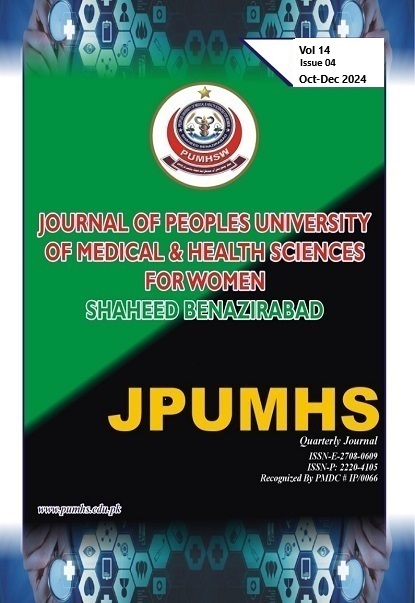INTRACRANIAL AND INTRAORBITAL EXTENSION OF ALLERGIC FUNGAL RHINOSINUSITIS IN PATIENTS PRESENTING AT TERTIARY CARE HOSPITAL.
JPUMHS;2024:14:04,71-78. http://doi.org/10.46536/jpumhs/2024/14.04.562
Keywords:
Sinusitis, Intraorbital Extension, Intracranial Extension, Fungal Sinusitis, Allergic RhinitisAbstract
BACKGROUND: Allergic fungal rhinosinusitis AFRS is a distinct subtype of chronic
rhinosinusitis CRS, affecting approximately 5%–10% of cases. It occurs due to an
exaggerated immune response to fungal colonization, leading to persistent inflammation.
Unlike typical fungal infections, AFRS develops in immunocompetent individuals who
exhibit strong allergic reactions. Diagnosis is typically confirmed through sinus surgery, and
treatment involves both medical management and surgical intervention. OBJECTIVE: This
study aimed to assess the frequency of intracranial and intraorbital extension in AFRS
patients. METHODS: A cross-sectional study was conducted in the ENT Department of
Shaikh Zayed Hospital, Lahore, from January to July 2018. Patients aged 20–60 years with a
confirmed diagnosis of AFRS were included. Demographic details, disease duration, and
comorbidities such as diabetes and hypertension BP >140/90 were recorded. Data analysis
was performed using SPSS version 20. RESULTS: The study included participants with a
mean age of 41.23 ± 9.27 years, with males making up 59% of cases. Diabetes was observed
in 43% of patients. Intracranial extension was present in 39% of cases, while intraorbital
extension was more common, occurring in 73%. A significant association was noted between
diabetes and intraorbital extension p < 0.05, as well as between prolonged disease duration
and intracranial extension p = 0.03. CONCLUSION: The high prevalence of intraorbital
extension in AFRS highlights the need for early detection and timely intervention. Prompt
management is crucial to prevent severe orbital and neurological complications. Further
research is needed to refine diagnostic and treatment approaches for better patient outcomes.
Downloads
Downloads
Published
How to Cite
Issue
Section
License

This work is licensed under a Creative Commons Attribution-NoDerivatives 4.0 International License.




